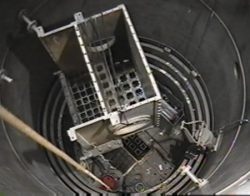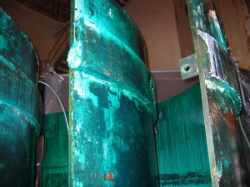|
Reactor
Decommissioning
History
NASA's Plum Brook Reactor
revised 8/26/06
Overview
The main Plum Brook reactor was
a 9-foot (2.7-meter) diameter x 31-foot (9.4-meter) tall PWR test reactor.
Operated by NASA (NRC license TR-3) it had a
generating capacity of 60 MW and was not capable of producing electricity.
It was operated from 1963 to 1973 with full power operations totaling
98,000 MW-days. It was decommissioned while the facility was in a "cold
and dark" state. Reactor disassembly began in 2003 and was completed
early 2005.
A second reactor (NRC
license R-93) was also decommissioned at this facility during this time.
It is not discussed in this document.
Reactor Decommissioning
Specifics
Internals Removal
 All
work was performed dry because of the condition of the reactor tank and
the lack of water processing on the site. All the work on the internals
was done remotely until dose levels allowed the final pieces to be removed
hands on. Dose levels prohibited using standard long handle tools from
a platform. Instead, operators were positioned 20-feet (6-meters) above
the work and 6-feet (2-meters) from the edge. Although a shield was used
it's ALARA benefit was to keep the operators outside of the gamma "plume"
that was exiting the vessel opening. All
work was performed dry because of the condition of the reactor tank and
the lack of water processing on the site. All the work on the internals
was done remotely until dose levels allowed the final pieces to be removed
hands on. Dose levels prohibited using standard long handle tools from
a platform. Instead, operators were positioned 20-feet (6-meters) above
the work and 6-feet (2-meters) from the edge. Although a shield was used
it's ALARA benefit was to keep the operators outside of the gamma "plume"
that was exiting the vessel opening.
To minimize a potential Tritium
release no thermal cutting of the reactor internals was done inside the
reactor. Remote shears, saws, and wrenches were extensively used. Two
of the thirty-four Beryllium components were believed cracked (from 1972
log books) and potentially would release large quantities of Tritium if
jarred, dropped, or heated. Special tools were designed and these two
items successfully removed and packaged. Also, a Secondary
Cutting Station was occasionally used to size reduce large components
using thermal cutting.
Internals were cut and removed in a sequence opposite that
of most reactor decommissionings (see our Yankee Rowe listing for an explanation).
The higher activated components were cut before the lower activated components.
This was to reduce the source term as quickly as possible. This approach
was desired because of lack of water shielding and the high quantity of
components to be removed from the vessel. Strict engineering controls
resulted in very little, if any, high level particles found mixed with
the low level components.
All work on the internals was
done by Wachs Technical Services (WTS).
Reactor Vessel Removal
 The
pressure vessel was carbon steel with a stainless clad and a maximum thickness
of 2-inches (50mm). Because the reactor was imbedded in the concrete bio-shield
an intact removal was considered cost prohibitive. Mechanical segmentation
was performed dry by Wachs Technical Services. Because of low dose rates
all cutting was done hands on. Most of the cutting was done using "Wall
Mills" (a type of milling machines used successfully on commercial
nuclear reactors and their internals for decades). Because
the outer vessel wall was wrapped in asbestos, Wachs supervised personnel
provided by the abatement contractor during these final cuts. Final cutting
of the reactor was done using thermal methods. The
pressure vessel was carbon steel with a stainless clad and a maximum thickness
of 2-inches (50mm). Because the reactor was imbedded in the concrete bio-shield
an intact removal was considered cost prohibitive. Mechanical segmentation
was performed dry by Wachs Technical Services. Because of low dose rates
all cutting was done hands on. Most of the cutting was done using "Wall
Mills" (a type of milling machines used successfully on commercial
nuclear reactors and their internals for decades). Because
the outer vessel wall was wrapped in asbestos, Wachs supervised personnel
provided by the abatement contractor during these final cuts. Final cutting
of the reactor was done using thermal methods.
Segmentation
and Packaging Plan (S&P Plan)
Pre-site: Wachs Technical Services (WTS); Gregg Smith
& Steve Larson.
At site: Wachs Technical
Services (WTS); Steve Larson.
Key
People
Steve Larson was the on-site Project Manager for Wachs.
Al
Solano was the on-site Project Manager for MWH responsible for the reactor
work.
Horst Kwech continued his streak of successful reactor Wall Mill designs.
Contractors
Wachs Technical Services (WTS).
MOTA (crane operation for the reactor work).
Framatome ANP (originally as Duke Engineering).
TolTest (asbestos abatement).
MWH.
USACE.
Argonne National Labs.
Comments
Although smaller than typical commercial power reactors it contained far
more internal components. Without the ability to flood
the vessel with water to shield the high radiation levels this could be
the most challenging reactor internals removal to date. It was the third
pressurized reactor vessel in the United States to have been segmented.
Related Publications and Documents
"The NASA Plum Brook Reactor Facility Decommissioning:
Status and Lessons Learned" by Keith M. Peecook of NASA for the ANS
DD&R 2005.
Click for newsletter.
References
"The NASA
Plum Brook Reactor Facility Decommissioning: Status and Lessons Learned"
by Keith M. Peecook.
NASA's web page as of 8/13/05.
Wachs Technical Services as of 8/12/05.
Steve Larson interview 8/12/05.
Click here
to return to the Reactor Decommissioning History main page.
|



